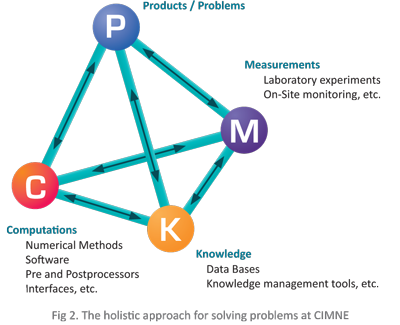The mission and activity of CIMNE can be clarified if we examine what we call the Cycle of Ideas1. Fig. 1 shows the scheme of the transit of an idea, from the instant it originates until it is transformed in an industrial and commercial success. Similarly to what it happens in biological and environmental cycles (the water cycle for instance), the cadencies and tempos are very important in the Cycle of Ideas.

Ideas (and here we refer to scientific advances) usually originate in university environments, where many professionals have the mission of studying, investigating and eventually discovering new areas of knowledge. The idea (the new discovery) would be equivalent to a seed, that even being very important it is far from becoming a fruit.
The idea matures in its "tour" by the first quadrant of the Cycle (the University) until it produces tangible results (thesis, papers, computer programs, physical devices, etc.). These "results", if they are not filed and protected, can be easily lost. This leads to undesirable repetitions or duplications.
What to do then with the results of an idea? The best is that they evolve until they reach the level of a prototype; i.e. something (a software code, a system, a device, etc.) that works in a contrastable manner.
The transit of a result to a prototype demands an organization, efficient and capable staff and resources. What it is desirable is that the idea follows its route on specialized institutions, adjacent to the university, such as CIMNE, with the mission of transforming knowledge into tangible things (prototypes). The prototype develops into a product within a company. The cycle follows with the marketing of the product and ends up with the reinvestment of part of the revenues from the marketing activities in the development of new ideas.
The overall research and technological development (RTD) activities of CIMNE has evolved over the years towards providing comprehensive solutions for solving problems that affect human beings. This can be achieved by integrating existing knowledge in a particular field with quantitative information emanating for prediction methods (i.e. computational-based techniques) and experimental measurements. The link between these four concepts: the problem to be solved, computational methods, experimental methods and existing knowledge is conceptually represented by the tetrahedron shown in Fig. 2 below.

Each of the nodes in the tetrahedron is connected to the other three by lines that represent information transfer pipelines (possibly internet). The intensity of the flow along the lines that interconnect two nodes will vary depending on the requirements for solving the problem.
